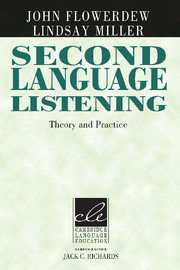Book contents
- Frontmatter
- Contents
- Series editor's preface
- Preface
- Acknowledgments
- Part I HISTORICAL BACKGROUND
- 1 Approaches to Language Teaching and the Role of Listening
- 2 Models of Listening
- 3 Types of Meaning for Listening
- 4 The Nature of Spoken Language
- 5 Learning Styles and Listening Strategies
- Part II A PEDAGOGICAL MODEL AND ITS APPLICATION
- Part III KEY ISSUES IN TEACHING AND TESTING
- Appendix: Concluding Questions for Reflection
- References
- Index
4 - The Nature of Spoken Language
Published online by Cambridge University Press: 04 February 2010
- Frontmatter
- Contents
- Series editor's preface
- Preface
- Acknowledgments
- Part I HISTORICAL BACKGROUND
- 1 Approaches to Language Teaching and the Role of Listening
- 2 Models of Listening
- 3 Types of Meaning for Listening
- 4 The Nature of Spoken Language
- 5 Learning Styles and Listening Strategies
- Part II A PEDAGOGICAL MODEL AND ITS APPLICATION
- Part III KEY ISSUES IN TEACHING AND TESTING
- Appendix: Concluding Questions for Reflection
- References
- Index
Summary
Introduction
In the previous chapter, we outlined how different types of meaning had to be accounted for in any model of listening comprehension. In this chapter, we focus on the need to consider different types of text.
One common approach in preparing second language learners for listening comprehension is for the teacher to focus on examples of written text and then expect the learners to transfer this knowledge when interpreting spoken texts. For example, a teacher may ask the learners to read a series of questions, listen to a taped recording of a scripted text, and then write answers to the questions. The focus, in this case, is as much on interpreting written text as it is on listening comprehension. As we illustrate in this chapter, spoken and written texts are very different and need to be taught in different ways. In addition to this, much of the listening practice that takes place in the classroom context focuses learners on large chunks of information (similar to a lecture), whereas in real life we do most of our listening in conversational settings. Conversations have very special features that are all too often neglected in second language classrooms.
Notwithstanding the importance of conversation and the emphasis on scripted text in classroom listening activities, spoken text itself can take many forms. For example, it can be distinguished in two broad ways: the type of information given and the amount of time taken. A lecture is an example of what Brown and Yule (1983) identify as transactional language (giving information) and is usually characterized by the speaker having long turns.
- Type
- Chapter
- Information
- Second Language ListeningTheory and Practice, pp. 47 - 61Publisher: Cambridge University PressPrint publication year: 2005



